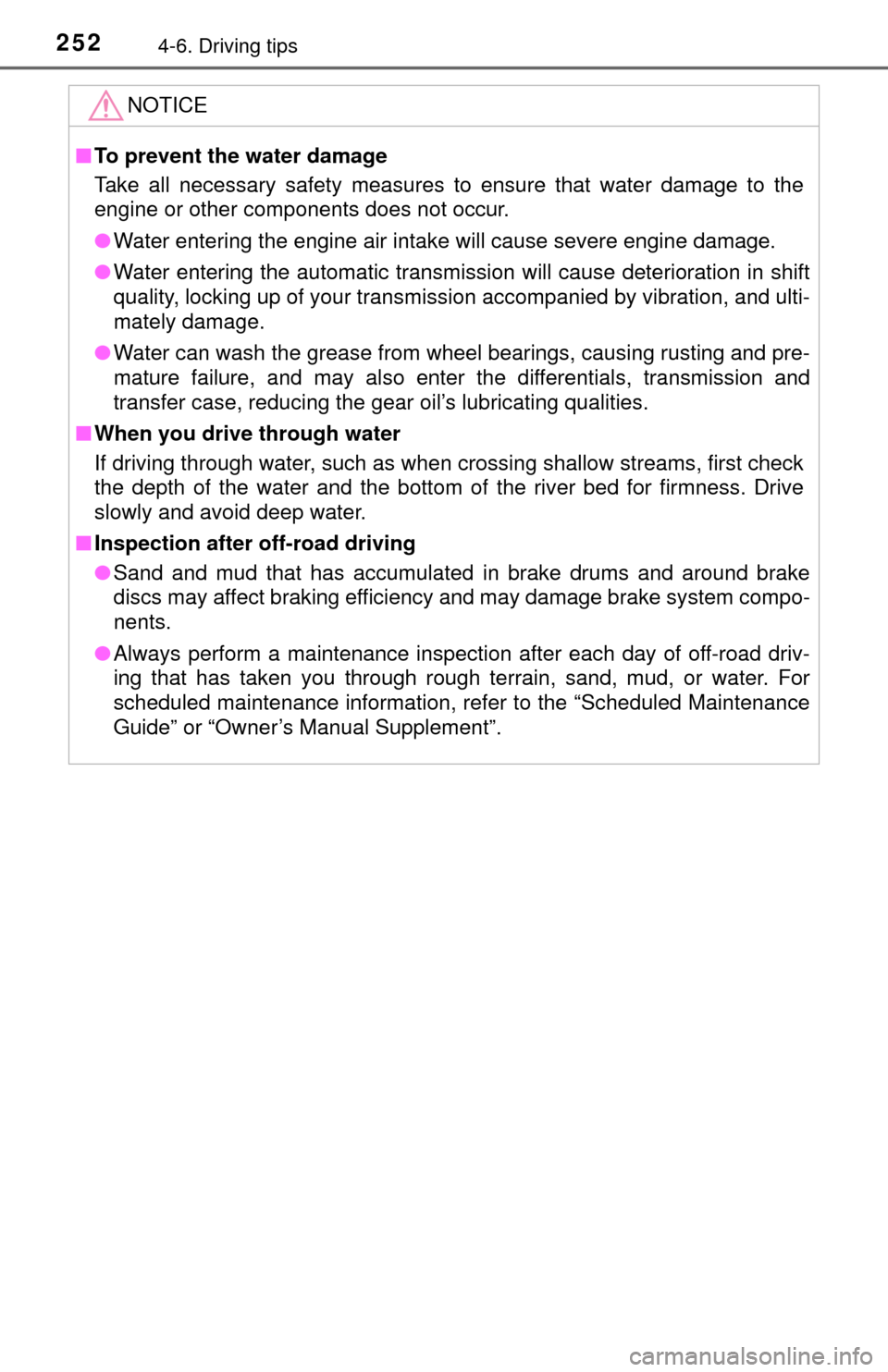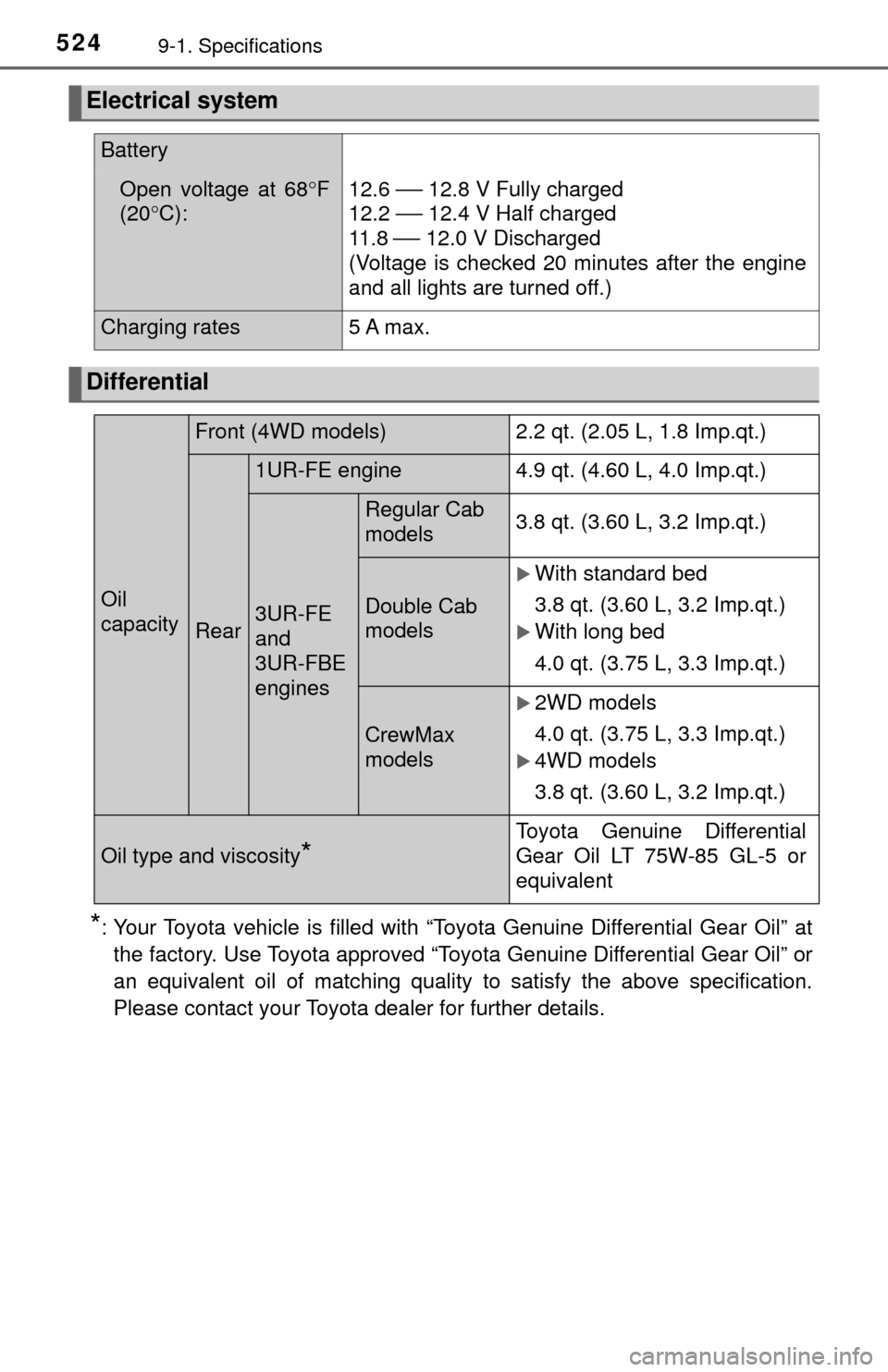2017 TOYOTA TUNDRA differential
[x] Cancel search: differentialPage 152 of 588

1524-1. Before driving
NOTICE
■When driving the vehicle
● Do not depress the accelerator and brake pedals at the same time during
driving, as this may restrain driving torque.
● Do not use the accelerator pedal or depress the accelerator and brake
pedals at the same time to hold the vehicle on a hill.
■ When parking the vehicle
Always set the parking brake, and shift the shift lever to P. Failure to do so
may cause the vehicle to move or the vehicle may accelerate suddenly if
the accelerator pedal is accidentally depressed.
■ Avoiding damage to vehicle parts
● Do not turn the steering wheel fully in either direction and hold it there for
an extended period of time.
Doing so may damage the power steering pump.
● When driving over bumps in the road, drive as slowly as possible to avoid
damaging the wheels, underside of the vehicle, etc.
■ If you get a flat tire while driving
A flat or damaged tire may cause the following situations. Hold the steering
wheel firmly and gradually depress the brake pedal to slow down the vehi-
cle.
● It may be difficult to control your vehicle.
● The vehicle will make abnormal sounds or vibrations.
● The vehicle will lean abnormally.
Information on what to do in case of a flat tire ( →P. 486)
■ When encounterin g flooded roads
Do not drive on a road that has flooded after heavy rain, etc. Doing so may
cause the following serious damage to the vehicle:
● Engine stalling
● Short in electrical components
● Engine damage caused by water immersion
In the event that you drive on a flooded road and the vehicle is flooded, be
sure to have your Toyota dealer check the following:
● Brake function
● Changes in quantity and quality of oil and fluid used for the engine, trans-
mission, transfer (4WD models) differentials, etc.
● Lubricant condition for the propeller shaft, bearings and suspension joints
(where possible), and the function of all joints, bearings, etc.
Page 178 of 588

1784-1. Before driving
■Break-in schedule
If your vehicle is new or equipped with any new power train components
(such as an engine, transmission, differential or wheel bearing), Toyota rec-
ommends that you do not tow a trailer until the vehicle has been driven for
over 500 miles (800 km).
After the vehicle has been driven for over 500 miles (800 km), you can start
towing. However, for the next 500 miles (800 km), drive the vehicle at a speed
of less than 50 mph (80 km/h) when towing a trailer, and avoid full throttle
acceleration.
■ Maintenance
●If you tow a trailer, your vehicle will require more frequent maintenance due
to the additional load. (See “Owner’s Warranty Information Booklet” or
“Scheduled Maintenance Guide”/“Owner’s Manual Supplement”.)
● Retighten the fixing bolts of the towing ball and bracket after approximately
600 miles (1000 km) of trailer towing.
■ If trailer sway occurs
One or more factors (crosswinds, passing vehicles, rough roads, etc.) can
adversely affect handling of your vehicle and trailer, causing instability.
●If trailer swaying occurs:
• Firmly grip the steering wheel. Steer straight ahead.
Do not try to control trailer swaying by turning the steering wheel.
• Begin releasing the accelerator pedal immediately but very gradually to reduce speed.
Do not increase speed. Do not apply vehicle brakes.
If you make no extreme correction with the steering or brakes, your vehicle
and trailer should stabilize. (if enabled, Trailer Sway Control can also help to
stabilize the vehicle and trailer.)
● After the trailer swaying has stopped:
• Stop in a safe place. Get all occupants out of the vehicle.
• Check the tires of the vehicle and the trailer.
• Check the load in the trailer.
Make sure the load has not shifted.
Make sure the tongue weight is appropriate, if possible.
• Check the load in the vehicle. Make sure the vehicle is not overloaded after occupants get in.
If you cannot find any problems, the speed at which trailer swaying occurred
is beyond the limit of your particular vehicle-trailer combination.
Drive at a lower speed to prevent instability. Remember that swaying of the
towing vehicle-trailer increases as speed increases.
Page 252 of 588

2524-6. Driving tips
NOTICE
■To prevent the water damage
Take all necessary safety measures to ensure that water damage to the
engine or other components does not occur.
● Water entering the engine air intake will cause severe engine damage.
● Water entering the automatic transmission will cause deterioration in shift
quality, locking up of your transmission accompanied by vibration, and ulti-
mately damage.
● Water can wash the grease from wheel bearings, causing rusting and pre-
mature failure, and may also enter the differentials, transmission and
transfer case, reducing the gear oil’s lubricating qualities.
■ When you drive through water
If driving through water, such as when crossing shallow streams, first check
the depth of the water and the bottom of the river bed for firmness. Drive
slowly and avoid deep water.
■ Inspection after off-road driving
● Sand and mud that has accumulated in brake drums and around brake
discs may affect braking efficiency and may damage brake system compo-
nents.
● Always perform a maintenance inspection after each day of off-road driv-
ing that has taken you through rough terrain, sand, mud, or water. For
scheduled maintenance information, refer to the “Scheduled Maintenance
Guide” or “Owner’s Manual Supplement”.
Page 524 of 588

5249-1. Specifications
*: Your Toyota vehicle is filled with “Toyota Genuine Differential Gear Oil” atthe factory. Use Toyota approved “Toyota Genuine Differential Gear Oil” or
an equivalent oil of matching quality to satisfy the above specification.
Please contact your Toyota dealer for further details.
Electrical system
Battery
Open voltage at 68 °F
(20° C):12.6 ⎯ 12.8 V Fully charged
12.2
⎯ 12.4 V Half charged
11 . 8
⎯ 12.0 V Discharged
(Voltage is checked 20 minutes after the engine
and all lights are turned off.)
Charging rates5 A max.
Differential
Oil
capacity
Front (4WD models) 2.2 qt. (2.05 L, 1.8 Imp.qt.)
Rear
1UR-FE engine4.9 qt. (4.60 L, 4.0 Imp.qt.)
3UR-FE
and
3UR-FBE
engines
Regular Cab
models3.8 qt. (3.60 L, 3.2 Imp.qt.)
Double Cab
models
With standard bed
3.8 qt. (3.60 L, 3.2 Imp.qt.)
With long bed
4.0 qt. (3.75 L, 3.3 Imp.qt.)
CrewMax
models
2WD models
4.0 qt. (3.75 L, 3.3 Imp.qt.)
4WD models
3.8 qt. (3.60 L, 3.2 Imp.qt.)
Oil type and viscosity*
Toyota Genuine Differential
Gear Oil LT 75W-85 GL-5 or
equivalent
Page 576 of 588

576Alphabetical index
Daytime running light system .................................... 195
Deck hooks .............................. 383
Defogger Back window ................. 348, 355
Outside rear view mirrors ........................ 348, 355
Windshield .................... 348, 355
Differential ................................ 524
Dimensions .............................. 510
Dinghy towing .......................... 181
Display Multi-information display ......... 90
Trip information ....................... 91
Warning message ................. 482
Do-it-yourself maintenance .... 413
Doors ........................................ 100
Automatic door locking and unlocking system ......... 104
Door glasses ......................... 134
Door lock............................... 103
Open door warning light........ 476
Open door warning message ............................. 483
Outside rear view mirrors...... 130
Rear door child-protector ...... 104
Side doors............................. 100
Driver’s seat position
memory .................................. 116
Driving ...................................... 146 Break-in tips .......................... 147
Correct driving posture ........... 30
Driving assist system ............ 235
Procedures ........................... 146
Winter drive tips .................... 245 EDR (Event data recorder)........ 10
Emergency, in case of
If the engine will not start ...... 501
If the vehicle has discharged battery ................................ 502
If the warning buzzer sounds................................ 475
If the warning light turns on ....................................... 475
If the warning message
is displayed ........................ 482
If you have a flat tire ............. 486
If you lose your keys ............... 98
If you think something is wrong .............................. 473
If your vehicle becomes
stuck ................................... 507
If your vehicle has to be stopped in an emergency ... 467
If your vehicle needs to be towed......................... 468
If your vehicle overheats....... 505
Emergency flashers ................ 466
Engine “ACC” position ...................... 182
Compartment ........................ 416
Engine switch ....................... 182
Hood ..................................... 415
How to start the engine......... 182
Identification number ............ 519
If the engine will not start ...... 501
Ignition switch
(engine switch) ................... 182
Immobilizer system .. ............... 78
Overheating .......................... 505
DE
Page 581 of 588

581Alphabetical index
Noise from under vehicle............ 8
Odometer.................................... 90
Off-road precautions ............... 249
Oil Engine oil .............................. 521
Differential oil ........................ 524
Transfer oil ............................ 525
Opener
Hood ..................................... 415
Outer foot lights Location ................................ 363
Replacing light bulbs............. 461
Wattage ................................ 528
Outside rear view mirrors ....... 130
Adjusting and folding ............ 130
Blind spot monitor ................. 222
Mirror position memory ......... 116
Outside rear view mirror defoggers ......... 348, 355
Outside temperature
display .................................... 386
Overhead console ................... 375
Overheating.............................. 505 Parking assist sensors
(intuitive parking assist)....... 207
Parking brake........................... 192 Operation .............................. 192
Parking brake engaged
warning buzzer ................... 475
Parking brake engaged
warning message ............... 483
Parking lights........................... 193 Light switch ........................... 193
Replacing light bulbs .... 453, 461
Wattage ................................ 528
Pen holder ................................ 373
Personal lights......................... 364
Light switch ........................... 364
Wattage ................................ 528
Power back window ................ 138
Power easy access system .... 116
Power outlets ........................... 387
Power steering fluid ................ 422
Power windows ....................... 134 Jam protection function ........ 135
Operation .............................. 134
Window lock switch .............. 134
N
O
P